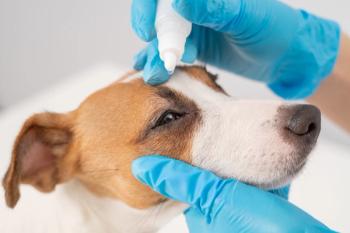
Perivascular Injection of Synthetic Adrenocorticotropic Hormone in Dogs
A recent study compared results of ACTH stimulation testing using the intravenous and perivascular routes of injection.
According to a study recently published in the
The ACTH stimulation test is used commonly to screen for HAC and diagnose hypoadrenocorticism in dogs and cats. In dogs with HAC, the test is also used to monitor treatment.
A sterile lyophilized powder form of synthetic ACTH is labeled for intramuscular or intravenous injection after reconstitution. A generic liquid form is labeled for intravenous use only. Regardless of the form used, the cost of ACTH stimulation testing can be high enough to deter some owners from having the test performed.
“Although both IV and intramuscular routes of ACTH administration are considered acceptable, subcutaneous administration of ACTH has never been evaluated,” write the authors. Extravasation of synthetic ACTH into the perivascular space “typically results in aborting the test or administering a repeat dose of ACTH, incurring additional cost.”
The investigators tested intravenous and perivascular administration of liquid synthetic ACTH (Cosyntropin, Sandoz Inc, Princeton, NJ) in 20 pet dogs at a specialty clinic in Los Angeles, California. Ten dogs had been previously diagnosed with naturally occurring HAC and were being treated with trilostane. Ten healthy dogs served as the control group.
Each dog underwent 2 ACTH stimulation tests, 1 with perivascular and 1 with intravenous ACTH injection, between 4 and 14 days apart. Five dogs in each group were randomized to receive intravenous injection first; 5 dogs in each group received perivascular injection first.
The researchers collected blood samples for cortisol assays before and 1 hour after ACTH administration. In dogs with hyperadrenocorticism, ACTH stimulation tests began 4 to 6 hours after trilostane administration. In healthy dogs, tests began between noon and 3 PM.
Results included the following:
- In all 20 dogs, baseline serum cortisol concentrations were not significantly different for the 2 tests, indicating that the first ACTH stimulation test did not affect the result of the second.
- In both groups, median serum cortisol concentrations were not significantly different after perivascular ACTH injection than after intravenous injection.
- In 8 of 10 healthy dogs, post-ACTH serum cortisol levels differed by less than 0.7 µg/dL after perivascular and intravenous injections of ACTH.
- In 8 of 10 dogs with HAC, serum cortisol was higher after intravenous injection than after perivascular injection. In 4 of these dogs, serum cortisol was higher by at least 1.2 µg/dL after intravenous administration than after perivascular administration.
For dogs being treated with trilostane, write the authors, the target post-ACTH cortisol level is between 1.5 and 9.1 µg/dL. In 1 dog with HAC, post-ACTH cortisol was 0.9 µg/dL after perivascular injection and 2.1 µg/dL after intravenous injection. For the other 9 dogs with HAC, they say, trilostane dosage recommendations would not have changed regardless of the route of ACTH administration.
Although median post-ACTH cortisol levels did not significantly differ after perivascular and intravenous administration in either group, the discrepancy between these values was higher in dogs with HAC than in healthy dogs. The authors suggest 2 possible reasons: HAC itself might affect the absorption of perivascular ACTH, and the timing of the test could have affected cortisol levels in these dogs. They note that varying the test time by as little as 2 hours after trilostane administration has been shown to change cortisol results.
The authors conclude that accidental perivascular administration of synthetic ACTH is not likely to significantly affect the results of routine ACTH stimulation testing.
Dr. Laurie Anne Walden received her doctorate in veterinary medicine from North Carolina State University. After an internship in small animal medicine and surgery at Auburn University, she returned to North Carolina, where she has been in small animal primary care practice for over 20 years. Dr. Walden is also a board-certified editor in the life sciences and owner of Walden Medical Writing, LLC. She works as a full-time freelance medical writer and editor and continues to see patients a few days each month.
Newsletter
From exam room tips to practice management insights, get trusted veterinary news delivered straight to your inbox—subscribe to dvm360.




